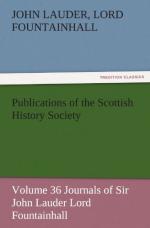To returne. From Over liberton saw the byway to St. Catharines Well, a quarter of a mile from Liberton, Leswaid, and Drodden;[518] then came to Libberton Kirk; then came neir to Libberton burne, and turned up to Blackfurd, wheir we saw Braids merches with Libberton moore, now arable ground, bought lately by the President.[519] Also wt Grange[520] saw Sacellum Sancti Marlorati Semirogues Chappell.[521] That burne that runes throw the Brighouse goes by Blackfurd to the Calsay[522] and Powburne, then to Dudiston Loch, out of which it runes again by West Dudiston milnes and is the Thiget burne.[523] Braides burne againe runes by Libbertone toune to Peppermilne, fra that straight to Nidrie by Brunstone and its milnes to the sea, a mile west of Musleburgh: the Magdalen[524] bridge layes over it their.
[518] Anciently Dredden, now Dryden.
[519] Sir John Gilmour.
[520] Dick of Grange. See Appendix I., p. 239, note.
[521] The two names seem to
denote the same chapel. St. Roque’s
Chapel
was on the Boroughmuir, half-a-mile west of Grange
House.
See
Bishop Forbes’s Kalendar of Scottish Saints
s.v.,
Semirookie:
’Aug. 16, 1327. Under this corruption we
find the
popular
designation of a chapel dedicated to St. Roque, just
outside
the east gate of Dundee.’ The other name,
distinctly
written,
looks like a corruption of St. Mary of Loretto.
Besides
the
more celebrated shrine at Musselburgh, there is a tradition
of
a
Loretto chapel near the Lady’s Wynd. Possibly
Lauder confused it
with
St. Roque’s Chapel.
[522] Causeway, highroad.
[523] So sometimes spelt,
more often Figgate or Fegot. The course of
the
two streams is incorrectly described.
[524] So called from a chapel to St. Mary Magdalen.
That nunnerie the walls wheirof are standing at the Cheyns[525] was destined most by[526] burgesses daughters, as also that whilk was in the Colledge Yaird called Monasterium Sanctae Mariae in Campis.
[525] Cheyns, now Sciennes, convent of St. Catherine of Sienna.
[526] Destined by, meaning ‘destined for,’ hence, ‘occupied by.’
Cheynes holds of the toun: they ware Robisons that possest it of old; Grange by the Cants; Craigmillar, Prestons, Edmistons, of that Ilk, now Reth,[527] first of that name being Chancellar Seaton his servand and carried the purse before him; Shirefhal, Giffards, then bought by the Earl of Morton, Lord Dalkeith, now it belongs to the Balcleuch; Preistfield (never kirk lands, tho the name would seime to say so), Hamilton, Tam of the Cougates[528] father; before them in the Chopmans; as also in the Cants.
[527] In 1671 the second son
of Wauchope of Niddrie married the
daughter
and heiress of Raith of Edmonston.




